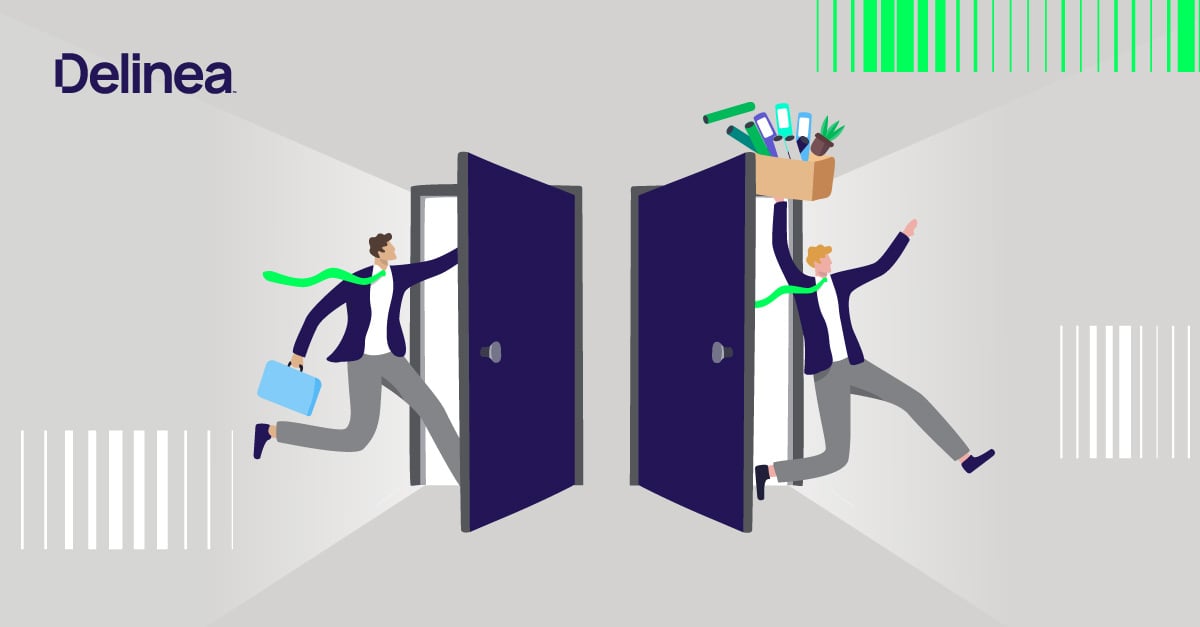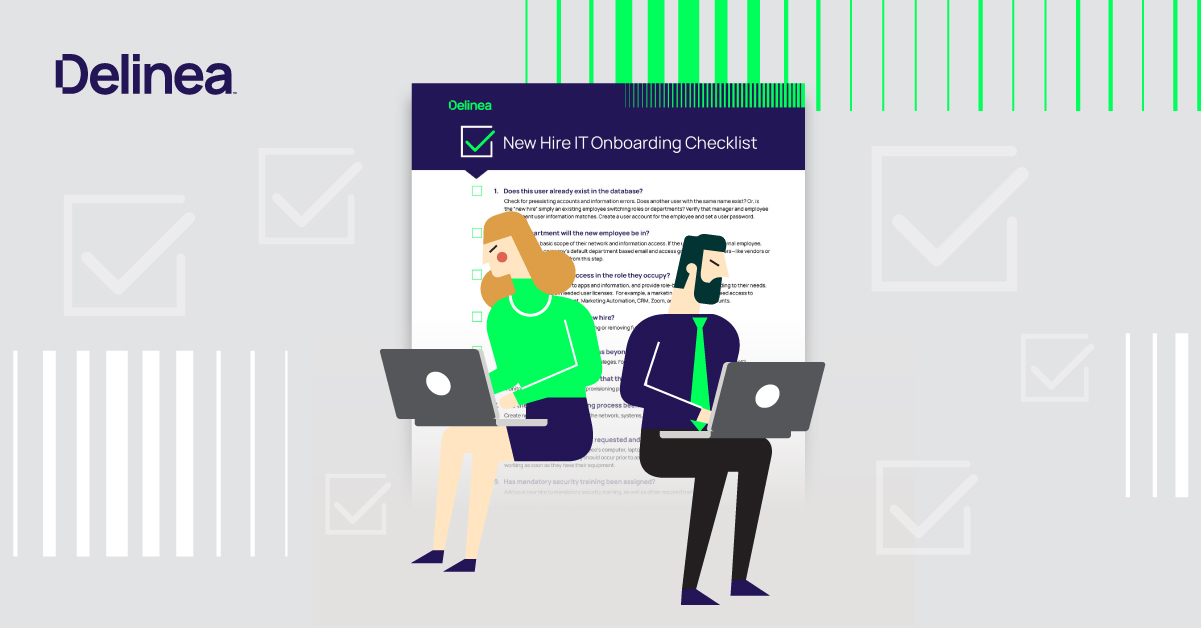IT offboarding checklist and templates to reduce security risk
Jump to the downloadable offboarding templates | Excel and Word
Jump to the offboarding checklist PDF
Employees come, and employees go, whether it's your decision or theirs. You either know someone who’s been affected, or you or your business has been affected by it in some way. Companies everywhere are transitioning jobs due to budget cuts, a dynamic market, and shifting priorities. Not only are transitions and layoffs difficult for those involved, but they are also a significant cybersecurity weak point.
Quick Hit: Layoffs often happen quickly, giving IT departments little time to prepare for a smooth and safe offboarding process.
Cyber risk increases when IT offboarding isn’t conducted effectively, even when an employee leaves of their own accord and gives plenty of notice.
In many companies, IT offboarding remains an afterthought. This is a mistake. Secure offboarding is every bit as important as onboarding. The good news is that by planning ahead and creating a practical IT offboarding checklist, you can reduce risk and avoid operational headaches and security blunders.
Why IT offboarding securely is critical
When employee offboarding isn’t secure, risks of insider threats and external cyberattacks increase.
For example, one recent report found that one in four employees still has access to company data from past employers. What’s more, 87% of employees who leave a job admit to taking data they created—like strategy documents and presentations. In addition, 28% say they’ve taken data that other people created. That means your company’s valuable IP and sensitive data are out in the world without any way to track them.
A poor IT offboarding process creates opportunities for external threat actors. For example, IT might fail to decommission email addresses properly, leave passwords in place, and ignore privileged accounts with standing access. Cybercriminals can leverage those entry points to gain access to your organization, and once inside, they can elevate that access to reach more sensitive and critical resources. Since those old accounts aren’t monitored, you’ll never know there’s a problem.
What’s the difference between unsecured and secure IT offboarding?
Unsecure IT offboarding tends to be disorganized, with inconsistent, haphazard decommissioning processes. This usually happens when companies lack a documented IT offboarding process and use multiple, disconnected systems to manually govern users, systems, applications, and devices.
On the other hand, a secure IT offboarding process is highly efficient, organized, and always aligned with the current state of your hardware, software, and computing environments. Take a look at any secure IT offboarding process and you’re bound to see some similar characteristics.
![]() Clear communication
Clear communication
IT offboarding requires careful communication and orchestration between executives, managers, human resources, legal, IT, and security teams. Internal teams work together to coordinate how a termination or separation will occur and execute it properly.
![]() Centralization
Centralization
Most employees use a mix of devices and multiple accounts, sometimes downloading software and applications without the knowledge of corporate IT. That’s why a secure IT offboarding process follows a centralized approach to manage user identities, privileges, and credentials across all systems and applications that employees use.
![]() Automation
Automation
It’s impossible to manage all employee identities, permissions, and applications manually—especially at scale. With an automated process, you can expire passwords after a certain time period and revoke access permissions with push-button ease.
The Ultimate IT Offboarding Template
Templates:
Download the IT offboarding template as an Excel spreadsheet: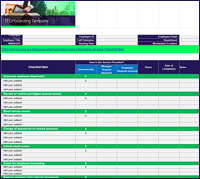
Download the IT offboarding template as a Word document: 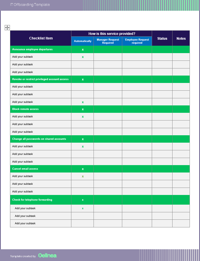
The Ultimate IT Offboarding Checklist
The employee offboarding process contains multiple stages. You can follow the recommendations of this IT offboarding checklist and create your own template to ensure you leave no stone unturned when offboarding employees.
1. Announce employee departures
Employers sometimes terminate workers privately, without alerting other team members. While this strategy may minimize disruptions, it can enable outgoing employees to continue to attend meetings, chat with team members, and request files, even as they have one foot out the door.
Because of this, make a point to formally announce departing staff. It may also help to inform team members about departing members’ termination dates and the current projects they’re wrapping up. This can prevent employees from exploiting colleagues who may not be aware of their expected departure.
2. Revoke or restrict privileged account access
Though rare, disgruntled departing employees may attempt to sabotage corporate resources as a means of revenge. This can significantly impact operations, damage client relationships, and cost money.
For example, an outgoing marketing employee could use a corporate social media account to post harmful materials and damage your brand reputation. Or, an IT team member like a system administrator could do even greater damage by shutting down business-critical systems operations that customers rely on.
To avoid these types of risks, immediately identify all systems they manage or have access to once you learn an employee is leaving—like applications, databases, cloud environments, or network devices. Transfer ownership to other team members and terminate their access to coincide with the departing employee’s last day.
Suppose an employee will be sticking around a while after announcing their departure. In that case, you may want to add an extra layer of approvals prior to granting them access to sensitive resources. Or, you could enforce stricter rules for Multi-Factor Authentication (MFA). This ensures business continuity and adds an extra layer of security to prevent outgoing workers from inflicting harm on your organization.
During high turnover or transition, it’s also a good idea to increase privileged activity session monitoring for signs of abuse. You’ll want to know if employees are suddenly downloading or sharing information in large volumes, moving contacts lists to personal accounts, or sending unauthorized messages to clients or partners.
3. Block remote access
Security and IT teams sometimes overlook remote access when offboarding employees. As a result, employees are sometimes able to continue accessing private resources using VPNs and other mechanisms. Make sure you consider all the ways your employees access resources, including all identities and access management systems they use.
4. Change all passwords on shared accounts
Workers often share privileged accounts among team members, perhaps to manage rotating monitoring or maintenance responsibilities. These shared privileged accounts make it impossible to track the activity of individual users. If your organization uses shared accounts, make sure you rotate passwords or create new accounts whenever a team member leaves.
Check your password habits against our 20 password management best practices.
5. Cancel email access
Email systems contain troves of valuable data, ranging from key contacts to sensitive files and internal communications. In many cases, employees continue accessing email systems after they stop working for a company.
Revoke email access at the end of the employee’s final day. In addition, monitor the outgoing employee’s account and set up email forwarding to handle future requests from customers or clients. That way, you’ll avoid confusing customers and impacting future projects.
6. Check for telephone forwarding
In some cases, employees will forward telephone numbers to external accounts—like their mobile numbers. Unhappy workers could even route telephone numbers to competitors out of spite.
Because of this, check to make sure that telephone numbers don’t connect to external numbers and that all systems are functioning as designed. In addition, deprovision employees’ voicemail accounts.
7. Remove mentions from internal documents
Companies are often slow to update internal documentation—especially during times of mass layoffs or restructuring. Unfortunately, this can make it look like previous team members are still with the company.
It’s important to remove all outgoing employee mentions from documents like contacts lists, websites, social media channels, documentation, and organizational charts.
8. Update physical access controls
It’s also necessary to update physical access to prevent former employees from entering offices, data centers, or storage locations. Change door codes and locks, revoke clearance cards, and take back any physical access wearables or devices that employees use.
9. Collect company-owned devices
Employees may be reluctant to return company-owned devices, especially if they use them for personal activities or other projects. Devices often store data locally, making them a security liability. These devices can also be expensive to replace.
For this reason, it’s a good idea to track company-owned devices—like laptops, desktops, mobile devices, tablets, cameras, and external storage devices.
10. Back up and secure critical files
For some former workers, it can be tempting to use important files as bargaining chips when negotiating with potential new employers, particularly if the information is sensitive or valuable. In the worst-case scenario, people may delete files or hold them for ransom for higher compensation.
You can avoid this risk by requiring team members to store information in company-owned accounts and regularly backing up and validating critical files. Restricting local data storage eliminates the threat of rogue or negligent account owners.
11. Create forensic computer images
Security issues can be difficult to detect. Sometimes, they may not appear for weeks or months after an employee leaves.
Create forensic images of an employee’s computer and securely retain them after the employee leaves. Doing so can aid in future investigations and help hold outgoing employees responsible for future security violations or data breaches.
12. Perform real-time network monitoring
IT should remain on high alert after an outgoing employee leaves the company. One way to accomplish this is to set up a Security Information and Event Management (SIEM) solution to detect suspicious behavior and restrict access. Network monitoring should take place around the clock, and all network communications devices must be monitored.
13. Conduct a thorough exit process
The last item on our offboarding checklist is one that's easy to overlook as interviews are, not surprisingly, associated with job applicants, not those terminating their employment. The exit interview is the company’s last chance to communicate with an employee before they part ways. As such, it’s critical to have security and IT administrators present to ask questions and go over last-minute items.
At this point, the employee should sign statements confirming the return of all company-owned assets. It’s also necessary to inform the employee not to access any systems, files, or accounts and to remind them of the repercussions that may ensue for doing so.
Download the offboarding checklist as a PDF: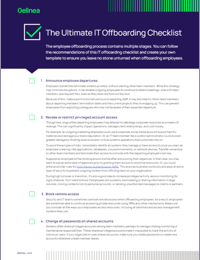
Bonus checklist for offboarding IT administrators
You should exercise greater caution when offboarding certain employees like domain administrators, systems administrators, developers, and security or operations professionals. These individuals have high levels of privileged access to sensitive resources that—if abused—could threaten the operational stability of your organization.
With that in mind, here are more recommendations to add to your checklist when offboarding high-risk IT employees.
Transfer knowledge in advance
Team leaders should meet with outgoing employees to ask questions and transfer knowledge. During this meeting, the departing employee should provide access to any sensitive systems they control and share information about where crown-jewel data lives.
Involve your legal team
In highly sensitive systems and data cases, it’s a good idea to bring the legal department into the fold when offboarding certain employees. Legal assistants can help advise on what questions to ask and help to properly document information (e.g., forensic computer files).
Securely offboarding employees starts with sound onboarding
At the end of the day, it’s much easier to offboard an employee securely if you handle employee onboarding correctly in the first place.
This requires establishing least privilege security and only granting access to information that people need to do their jobs. It’s also a good idea to use an enterprise Privileged Access Management (PAM) solution when establishing permissions and setting up rules to automatically review, rotate, and expire credentials, accounts, and access links.
In addition, managers and security administrators must maintain visibility into the systems and applications that workers can access. Companies should set policies to reduce instances of unauthorized SaaS services and shadow IT. What’s more, set up policies that govern the proper use of data and prevent employees from storing sensitive information on unsecure devices or in unauthorized locations.
To make sure you secure access at both the beginning and the end of the employee lifecycle, be sure to check out the companion to this offboarding checklist, Delinea’s new hire onboarding checklist.
Prioritize IT offboarding
Secure IT offboarding may not seem like a high priority when there are other important action items to tackle during layoffs, restructuring, or times of high turnover. But offboarding a high-risk employee is a big deal that requires proper time and care. Delaying the process and waiting until the last minute could create complications and put your company at risk.
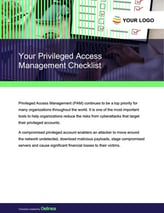
FREE CHECKLIST
Need a step-by-step guide for planning your strategic journey to privileged access security?
